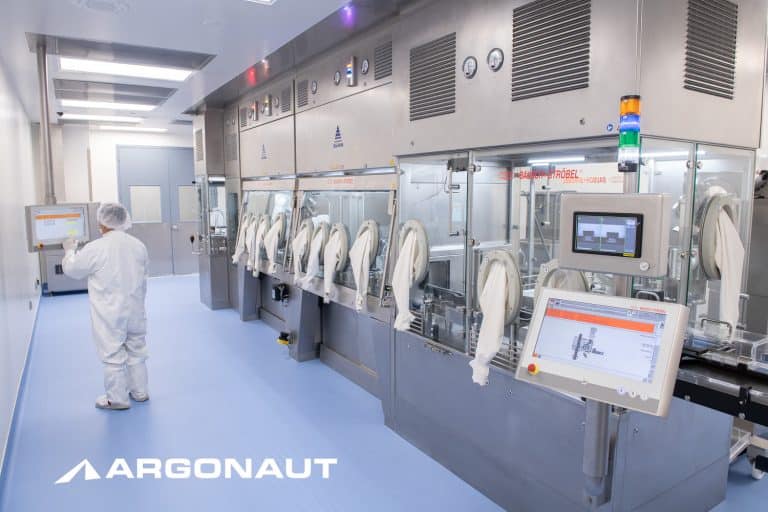Every biopharma company is eventually faced with the “make versus buy” decision – should they do the fill/finish manufacturing of their drug product in-house or outsource? Complicating things further, a third option also exists to outsource a portion while retaining some internal capabilities. For most companies, the choice to make or buy is not straightforward. Argonaut frequently works with clients while they evaluate their manufacturing needs, and we have assembled a list of common decision points for make versus buy in aseptic fill/finish. End the internal debate over how to fill and finish your drug product by using the evaluation criteria and table below.
Does your company have a sufficient budget for adding necessary equipment, personnel, and facility updates?
Adding drug product fill/finish capabilities can be expensive. In addition to equipment, you will also need to hire experienced staff and update your facility to house the new line. Drug product manufacturing requires a large team across multiple departments, including technicians, technical operations, regulatory, and quality. Be sure to calculate incremental expenses in direct labor, capital, purchasing, managerial, and factory operations. These expenses combined can quickly add up to millions of dollars, a difficult sum to take on as a young company. Even companies with existing fill/finish equipment may feel the pinch when upgrading to the newest technologies. More stringent regulations are leading drug manufacturers to introduce features including isolators and automation, which can be costly to add. Working with a Contract Manufacturing Organization (CMO) avoids the high cost of implementation and upgrading that in-house fill/finish manufacturing can require.
Working with a Contract Manufacturing Organization (CMO) avoids the high cost of implementation and upgrading that in-house fill/finish manufacturing can require.
Will new equipment be fully utilized?
It is important to consider whether equipment will be used frequently. For large-scale drug products, the costs of implementing and operating your own fill/finish manufacturing line may be more economical than outsourcing. However, precision medicine has led a recent wave of small-batch therapies that do not justify their own dedicated line. For projects that do not fully utilize their manufacturing equipment, outsourcing can be the cost-effective solution.
Will new equipment be used long term?
If you do not plan to manufacture this product long term, outsourcing is a better option than implementing in-house. This is common for drugs in the clinical trials phase, since scaling up to commercial manufacturing may have different requirements.
Does manufacturing capability and knowledge already exist in-house?
Companies that already manufacture similar products are at an advantage. Having the appropriate equipment and expertise available makes in-house fill/finish manufacturing the more appealing choice. However, you may have some, but not all, of the necessary capabilities to complete your project. Partial outsourcing is an option that takes advantage of existing resources without the need to add more in-house.
Partial outsourcing is an option that takes advantage of existing resources without the need to add more in-house.
Does your existing manufacturing line have capacity to support this project?
This is an important caveat to in-house fill/finish capabilities. While fill/finish infrastructure may be in place, it is possible that it is already running at full capacity. Be sure to evaluate whether there is excess capacity to add additional products to the existing workload before opting to manufacture internally.
Is your existing manufacturing line scalable to meet forecasted demand?
Look forward to the future. Will your existing manufacturing line meet your forecasted fill/finish demand, and if not, is it cost-effective to upgrade it? If not, contract manufacturing is a good option for either surge capacity or to cover the entire project.
Are in-house implementation lead times longer than the desired production timeline?
Drug manufacturing equipment is notorious for long lead times, in some cases taking years to acquire the machinery. Media fills and regulatory approval can extend this even further. Starting the process in advance can help you meet timelines, but it also means costly expenditures years before any production begins. Companies with financial security and production deadlines far in the future can comfortably bring manufacturing in-house, but outsourcing is a good solution for those with short timelines or a dwindling cash runway.
Drug manufacturing equipment is notorious for long lead times, in some cases taking years to acquire the machinery.
Do you want or need a multiple source capacity?
To de-risk projects, a sustaining strategy is having capacity in two or more locations. This can keep production on track in the event of a failure to produce at one of the locations. Engaging with a CMO for fill/finish manufacturing can serve as a bridge while building internal capacity, while at the same time providing a second manufacturing site.
Will fill/finish manufacturing in-house detract from your overall focus?
Focus is one of the most commonly overlooked factors in the make versus buy decision. Outsourcing enables companies to focus on innovation and R&D rather than mundane fill/finish manufacturing operations. Handing those responsibilities to a CMO frees up personnel and funds for more critical internal activities.
Every biopharma company is eventually faced with the “make versus buy” decision – should they fill/finish their drug product in-house or outsource?
The make versus buy decision for drug product fill/finish manufacturing is not straightforward, but careful evaluation of the criteria above can help guide you. Companies with established manufacturing capacity or a large enough scale to fully utilize new equipment may benefit from in-house fill/finish. However, companies with smaller scales, short timelines, or those looking to avoid the significant expenses of implementing their own in-house line will find contract fill/finish manufacturing to be the best path forward. By taking these factors into consideration, you can move forward confidently.
Is contract fill/finish manufacturing the right path for your project? Contact the Argonaut team to learn more about our drug product manufacturing solutions.


